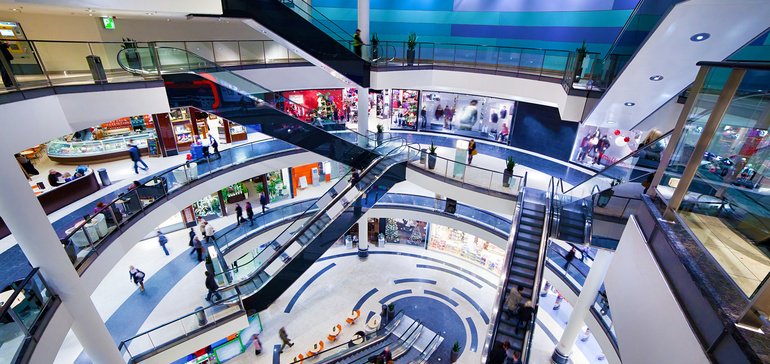Malls aren’t dead, but they are changing — and store-based technology is helping to re-imagine the American shopping experience
The following is a guest post from Tony Scherba, president and a founding partner of Yeti LLC, a product-focused development and design studio in San Francisco.
It’s an understatement to say that American malls are having a hard time. In the next five years, 20-25% of American malls are set to close, according to Credit Suisse.
Why have Americans deserted the nation’s most iconic retail fixtures? It’s certainly not because shoppers are spending less. Since 2010, U.S. consumer spending rose from less than $10 trillion to nearly $12 trillion in July 2017. Meanwhile, between 2010 and 2013 alone, mall visits declined by 50% and since then, they’ve been free-falling.
The easy answer is that Amazon has eaten malls’ lunch. Between 2010 and 2016, Amazon sales quintupled from $16 billion to $80 billion, and 50% of American households are Prime members.
The harder answer, frankly, is that malls haven’t kept up with technology — a major reason Amazon got a foothold in the first place. Technologies like augmented and virtual reality, mobile beacons and chatbots are viable in retail contexts, but most malls have yet to adopt them.
Still, malls have plenty of reasons to be optimistic. They occupy prime locations and retailers are generally getting better at satisfying customers. During the 2016 holiday season, the American Customer Satisfaction Index awarded brick-and-mortar retailers 78 out of 100 points for customer satisfaction, up 4.7 percent from the prior report and an all-time high for the industry and Westfield Malls just sold for $15.7 billion.
It’s easy to look at the data and see a bleak fate for malls. But there are emerging technologies that have the potential to restore Americans’ penchant for malls. Malls aren’t dead, but they are changing.
Assuming they tap into these technologies, America’s malls will look far different by 2020.
1. Dressing rooms will go digital
Dressing rooms are a big reason why consumers flock to stores, especially older generations. While they can buy whatever they need online, 80% of Baby Boomers prefer touching and feeling products before purchasing them. This creates an opportunity for malls and their retailers to draw customers while optimizing showroom space.
Digital dressing rooms could make the whole shopping experience easier. Imagine customers being able to try on a single article of clothing for size and then select from a variety of colors and patterns. That’s exactly what Nike’s Paris store has done in partnership with French firm SmartPixels. Together, the two created a tablet that projects a lifelike hologram with different patterns onto customers’ shoes.
2. Stores will make more of mobile apps
We already know that mobile apps drive in-store purchases. In fact, 73% of shoppers are omnichannel customers who check multiple sources before purchasing. To take advantage of this, the Frye Company in San Francisco recently implemented RFID scanners that allow customers to scan an item and see other available options online.
Fashion designer Rebecca Minkoff took things a step further by launching her new line through Zeekit. Customers can upload a full-body image to the app to see what they’d look like wearing Minkoff’s latest threads. She even live-streamed her Fall Fashion Week show in virtual reality, leading the retail charge toward omnichannel marketing.
3. Augmented reality will draw shoppers and save money
Augmented reality is about to play a big role in retail. A recent survey by Interactions Consumer Experience Marketing found that 71% of shoppers would return to a retailer that used AR in its services. Another by Retail Perceptions found that 40% would pay more for a product experienced through AR.
Sephora, for one, wasted no time infusing AR into its mobile app. Shoppers using Sephora’s app can see how the store’s products will look on their faces, not to mention receive step-by-step application instructions. Just think how much Sephora could save on free samples if it installed AR on actual makeup counters.
4. The show floor and catalog will become one
Ikea’s stores have always contained decorated “rooms” that show how furniture and other goods could look set up in a customer’s home. Now, it’s outdoing itself with a 3D kitchen-building tool that replicates the exact dimensions of a shopper’s kitchen so he or she can see how it would look completely remodeled.
Shoppers are already using mobile apps in retail stores. It won’t be long before they can hold up a phone to see all the features, benefits, and pricing information for a product — just as if they’re holding your store’s look book in their hands. Customers shopping with this information may take longer to make a decision, but they exhibit double the conversion rates and spend twice as much as their peers.
5. Mirrors will become digital assistants
Data is what will save retailers across America. By using RFID tags and beacons inside mirrors, retailers can learn about what customers try on, buy, return and more.
Upscale fashion brands like Ralph Lauren, Neiman Marcus and Nordstrom are already experimenting with smart mirrors that can offer product recommendations and call associates. Imagine being able to display matching accessories and browsing history within the dressing room. It’s the one place sales staff can’t follow customers, so why not reach them digitally?
Although malls are down, they’re certainly not out. Millions of Americans visit retail stores to research and buy products every day. It’s only a matter of time until malls perfect these digital innovations to augment the customer experience.
The mall of 2020 will offer a digitally connected, physical, and immersive shopping experience. The technology to do it already exists; malls just need to embrace it. If they do, their renaissance is just around the corner.
by Tony Scherba

